Servicios Personalizados
Articulo
Indicadores
Links relacionados
-
 Citado por Google
Citado por Google -
 Similares en Google
Similares en Google
Compartir
South African Journal of Education
versión On-line ISSN 2076-3433
versión impresa ISSN 0256-0100
S. Afr. j. educ. vol.32 no.3 Pretoria ene. 2012
ARTICLES
Teaching practice and the personal and socio-professional development of prospective teachers1
S SchoemanI; P L MabundaII
IDepartment of Curriculum and Instructional Studies, College of Education, University of South Africa, Pretoria, South Africa schoes@unisa.ac.za
IIDepartment of Curriculum and Instructional Studies, College of Education, University of South Africa, Pretoria, South Africa
ABSTRACT
This study investigates the interplay between individual and contextual variables during teaching practice and its impact on the personal and socio-professional development of prospective teachers. The purpose of the study was to survey how prospective teachers experienced the process of becoming aware of their emerging identities as teachers, and to demonstrate how the unique, individual student teachers' teaching and socio-professional identities are cultivated in the learning-to-teach process. A non-experimental survey research design involving quantitative data was used. A questionnaire, adapted from Caires and Almeida's Inventory of Experiences and Perceptions at Teaching Practice (IEPTP), was used to collect the data. The data were assessed through statistical analysis, using mean ranking scores. Higher levels of success were observed with regard to the professional and institutional socialisation, learning and professional development, and vocational sub-scales. Lower levels of success were found in the support and supervision and socio-emotional sub-scales. Ralph's contextual supervision model and exploration of feelings and emotions are put forward as measures to scaffold, respectively, the supervision and socio-emotional dimensions of becoming a teacher.
Keywords: contextual supervision model; dimensions of becoming a teacher; initial teacher education; learning to teach; personal and socio-professional development; student teachers; teaching practice
Introduction
Higher education institutions offering initial teacher education (ITE) programmes in South Africa require, in terms of education policy documents (such as the Integrated Strategic Planning Framework for Teacher Education and Development in South Africa, 2011-2025, and The Minimum Requirements for Teacher Education Qualifications, 2011), that their students take part in a teaching experience in schools, where they can interact with the realities of classroom teaching and the school context (Department of Basic and Higher Education and Training, 2011:18; Department of Higher Education and Training, 2011:8). This is usually referred to as teaching practice (TP), school experience, practicum, induction or internship (Darling-Hammond, 2006:1-15; Department of Basic and Higher Education and Training, 2011:18; Liston, Whitcomb & Borko, 2006:35-38). In this study, the term teaching practice is used to refer to these field placements of student teachers (STs). Ways of organising the teaching practice vary across programmes and institutions (Botha & Nofomela, 2010:1). The researchers are responsible for teaching two teaching practice modules at the higher education institution where they are employed, "Teaching History" and "Teaching Social Sciences". This study is a critical reflection on two main aspects related to the teaching practice component of both modules, namely, what actually takes place during the students' school experience in becoming aware of their emerging identities as teachers, and the contribution of the school experience to the student teachers' unique, individual teaching and socio-professional development.
Background to the problem
This study examines the complexities involved in learning to teach. The Department of Basic and Higher Education and Training (2011:18) and Spalding, Klecka, Lin, Wang and Odell (2011:3) have pinpointed the complexity of learning to teach as a major obstacle to student teacher learning that teacher education programmes must address if they are to be successful. According to Borko, Whitcomb and Liston (2009:3), learning to teach is indeed a "wicked problem"; not only because student teachers learn to teach by drawing on a complex array of internal and external resources, which are difficult for researchers to disentangle and understand, but also because the process occurs over time and is contextualised, unpredictable, and idiosyncratic (Borko, Whitcomb & Liston, 2009:3; Darling-Hammond, 2006:1-15).
According to Caires and Almeida (2005:111-120), over the last three and a half decades, different approaches have emerged in the study of the process of becoming a teacher, which try to explain the complexities of the experience. Various studies, supported by different theoretical stances, have focused on different aspects of teaching practice, ranging from the cognitive and affective aspects of learning to teach, to the socialisation process that takes place during the first contact with the realities of classroom teaching and the school context (Burn, Hagger, Mutton & Everton, 2000:259-278; Robinson, 1999:1). Despite the coexistence of various approaches, it is widely accepted that the complex, interactive, dynamic and idiosyncratic nature of the process of learning-to-teach is largely influenced by the interplay between individual and contextual variables (Quick & Siebörger, 2005:1-4). Among them, the literature emphasises student teachers' personal characteristics and resources, the quality of learning experiences, the supervisors' support, and the quality of the school environment (Dean, 1996:13-20; Flores, 2007:146; John, 1991:8-12).
What is of relevance to this study, is the interplay between these individual and contextual variables during teaching practice, and its impact on the personal and socio-professional development of prospective teachers. The focus is on the student teachers at a South African higher education institution.
Research questions
The following three research questions (RQs) were formulated using two ofMouton's (2002:4) three categories pertaining to the research problem:
RQ1: What are the personal and socio-professional successes experienced and difficulties encountered by student teachers during teaching practice? (unit of analysis);
RQ2: What are the student teachers' opinion on the significance of teaching practice in their personal and socio-professional development? (unit of analysis); and
RQ3: How can the process of learning to teach and the professional development of student teachers be supported during teaching practice? (research goal, the "dream").
Purpose of the study
The purpose of the study was to
- investigate the interplay between individual and contextual variables that shape the learning-to-teach biographies of prospective teachers.
- survey student teachers' opinion about the significance of teaching practice in the process of becoming aware of their personal and socio-professional identities as teachers; and
- put forward measures to support the development of student teachers' individual, unique teaching and socio-professional identities.
Theoretical perspective
Educational research is essentially concerned with exploring and understanding social phenomena that are educational in nature, mainly pertaining to formalised and/or spontaneously occurring social, cultural, and psychological processes, which could be defined as education. In doing so, it deals with educational questions that can be investigated in a scientific manner, the methods that enable such scientific investigation, and implementation of results emanating from the investigation. Since theoretical questions in education emerge from different conceptions and interpretations of social reality, different paradigms have been evolved to determine the criteria according to which the educational researcher selects and defines his/her problems for inquiry. Positivism is one of the major philosophical branches in social sciences inquiry. The positivist paradigm of exploring social reality is based on the philosophical ideas of August Comte (1798-1857), who emphasised observation and reason as a means of understanding human behaviour (Dash, 1993:1-6). According to Comte, true knowledge is based on experience of the senses, and can be obtained by observation (participant observation during lesson presentation) and experimentation (professional development in the individual model of supervision versus the conceptual model of supervision). Educational researchers adopt a scientific method as means of knowledge generation. The scientific method is grounded in the framework of the principles and assumptions (determinism, empiricism, parsimony and generality) of science. The assumption is that there is an objective reality that can be known to the educational researcher. It asserts that real events can be observed empirically and explained with logical analysis. The criterion for evaluating the validity of educational scientific theory is whether knowledge claims (i.e. theory-based predictions) are consistent with the information the researcher is able to obtain using his/her senses. The positivist methodology emphasises micro-level experimentation in an environment that eliminates the complexity of the external world. In the social sciences, however, human volition and uncertainty make the experiment less reliable. Ultimately, its internal inconsistency resulted in the abandonment of positivism in favour of scientific approaches such as critical multiplism; which is based on the belief that no one approach is sufficient for developing a valid understanding of a phenomenon (Angen, 2000:378-395).
For the purposes of this study, the positivist methodology was retained. The reality of the study was the physical and social reality of the students who were enrolled for the two modules (Teaching History and Teaching Social Sciences); and their reality was independent of that of the researchers. The researchers' observation of the student teachers' reality was, therefore, unbiased (as part of the researchers' ethical consciousness); and, consequently, constituted scientific knowledge (realist ontology). The scientific inquiry of the study was grounded in positivist epistemology; and focused on the determination of general trends in the teaching practice experience of the prospective teachers (representational epistemology). The features of the social environment of the study (the placement schools and higher education institution) retained a high degree of constancy across time and space. A representative sample of the population (all the students on the class list) was selected. The findings obtained from studying the sample were generalised to the larger population (all student teachers enrolled for the modules). Deductive analysis was used to identify underlying themes and patterns. A mechanistic causality was identified among the social objects (the student teachers and the individual and contextual variables during teaching practice), (Dash, 1993:1-6; Neurath & Cohen, 1973: 343).
Conceptual framework
Socialisation theory has been used to study student teachers, teacher education programmes, and in-service teachers. Williamson and Stroot (1994:170-177) argue that by studying socialisation processes researchers are provided with insight into how students and educators learn to understand and fulfil their professional responsibilities. The most prevalent theoretical model used to describe the personal and socio-professional socialisation of teachers is Lawson and Stroot's (1993:437-446) occupational socialisation model. Lawson (1986:107) defines the concept occupational socialisation as "all ... kinds of socialisation that initially influence individuals to enter the field of education and that later are responsible for their perceptions and actions as ... teachers". According to this model, teachers are socialised in three phases, namely, anticipatory socialisation (potential teachers learn about teachers during their own schooling careers), professional socialisation (teacher education programmes engage student teachers in activities explicitly designed to shape them as teachers), and organisational socialisation (this phase starts once student teachers graduate; then all professional interactions continue to shape them as teachers).
One component of the professional socialisation phase, namely, field experience (the focus area of this study), has gained widespread recognition as being critical in the professional socialisation of teachers (Department of Basic and Higher Education and Training, 2011:1; Su, 1992:239-258). Dodds (1989:20-25) designed a teacher socialisation model that includes students' field experiences. In this model, five categories (which are centred on key features of educational settings) emerge as important to describe students' developing views of teachers and teaching (teaching perspectives). These categories are societal, sport, professional, organisational, and bureaucratic. The views of the student teachers are also shaped by numerous persons. Mentor teachers and learners are powerful socialising agents acting on student teachers during their field experiences (Ong'ondo & Jwan, 2009:415). The students themselves are also active agents, and undergo internal processes (self-socialising strategies) in the formation of their professional images within broader socialisation processes (Solmon, Worthy, Lee & Carter, 1990:188-209). Three aspects of Dodd's (1989:20-25) teacher socialisation model were applicable to this study, namely, the professional category of educational settings (developing the student teachers' teaching perspectives), the socialising agents (mentor teachers and learners acting on the student teachers during their field experiences), and the active agents (the student teachers' self-socialising strategies moulding their professional images).
Learning to teach: It's complicated
Cumulatively, the review of the literature has highlighted a range of issues (concerns with the self, instructional learning, teacher efficacy, pedagogical reasoning and personal practical knowledge) that confirm the complexity of learning to teach during teaching practice. A study by Numrich (1996:135) shows that student teachers involved in teaching practice are initially more concerned with their own survival in the classrooms, than with how to control the lear- ners and facilitate their learning. However, according to Tann (1994:81-93), with time, especially if the teaching practice period is extended and if the student teachers are well supported (work closely with supervisors), they are able to make rapid progress from primary concern with survival to thinking about how they could facilitate learning among the learners. Related to the issue of student teachers' preoccupation with themselves, research by Johnson (1996: 30-49) on student teachers' experiences shows that the theoretical modules in initial teacher education programmes do not seem to prepare the student teachers adequately for the practice.
Researchers (Dellicarpini, 2009:42-50) and Kohler, Henning & Usma-Wilches (2008: 210-211) have also explored the question of what student teachers learn or fail to learn during teaching practice. Some of the aspects which have been identified are that student teachers learn the skill of planning (Dellicarpini, 2009:42-50) and the ability to make instructional decisions (Kohler, Henning & Usma-Wilches, 2008:210-211). However, these researchers reported that the student teachers are not able to give clear explanations for the decisions they take during teaching.
Another issue that has been reported is the development of teacher efficacy among student teachers, defined as "the teacher's belief in his or her capability to organise and execute courses of action required to successfully accomplish a specific task in a specific context" (Liaw, 2009:176-180). Liaw (2009:176-180) showed that teaching practice enabled student teachers to improve in teacher efficacy, as defined above, especially when the teaching practice is extended and well supported, involving close cooperation between student teachers, mentor teachers and teacher educators.
Recently there have been some studies on pedagogical reasoning of student teachers during teaching practice (Phelan, 2009:93). In one such study, Phelan (2009:109) studied pedagogical reasoning defined in the study as "a teacher's capacity to discern particulars and make wise judgement about how to act in pedagogical situations and contexts". Phelan (2009: 109) suggests that student teachers are engaged in two types of reasoning, namely, instrumental reasoning and practical reasoning. She (2009:111) argues that instrumental reasoning is based on "propositional knowledge of literature and teaching methods", while practical reasoning is related to the student teacher's teaching in the classroom, and is based on "his perceptiveness in reading particular situations, and to imagine possible actions". Young and Birds (2009:4, 7) indicated that, when provided with support and the opportunity to work with instructors, student teachers are able to engage in pedagogical reasoning that would help them move toward mastery of teaching.
Some studies deal with the issue of personal practical knowledge (PPK). Golombek (1998: 448) defines PPK as "personal philosophies, metaphors, rhythms and narrative . as representing forms ... of practice". Golombek (1998:448-449) concludes that:
the student teachers' personal practical knowledge informed their practice by serving as a kind of interpretive framework through which they made sense of their classrooms as they recounted their experiences and made this knowledge explicit ... teachers' personal practical knowledge shapes and is shaped by understandings of teaching and learning.
Tsang (2004:163-198) discovered that PPK featured during the student teachers' post-lesson discussions as they discussed how the lessons could be improved. She attributed this, which she termed a delayed access to personal practical knowledge, "to competition between several issues including circumstances of the classroom, thoughts on teaching course work at university and the PKK".
Empirical study
Research design
A non-experimental survey research design involving quantitative data was used to generate data pertaining to student teachers' opinions on the successes experienced, difficulties encountered, and significance of the teaching practice experience in their personal and socio-professional development.
Questionnaire
A questionnaire based on the Inventory of Experiences and Perceptions at Teaching Practice (IEPTP) designed by Caires and Almeida (2005:111-120) was used to collect the data. The IEPTP included five sub-scales which described the teaching practice experience on five different aspects, using a self-anchored 5-point rating scale (from totally agree to totally disagree). The particulars of the IEPTPs sub-scales are provided in Table 1.
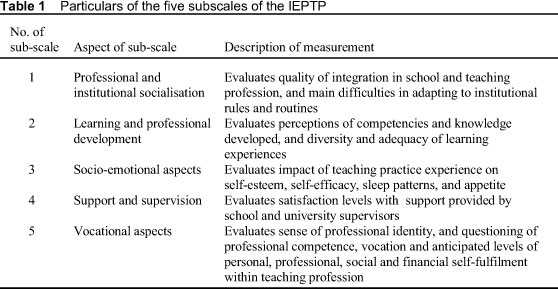
The 22 items taken and adapted from the IEPTP for this study are provided in Tables 2 to 6. Respondents were asked to read the opinion-related items 1 to 22. They were then requested to indicate on a Likert-type scale the strength of their agreement or disagreement regarding the extent to which the items of each sub-scale contributed to their personal and socio-professional development, by marking an X on a continuous scale ranging from SA, indicating strong agreement (6) to SD, indicating strong disagreement (1).
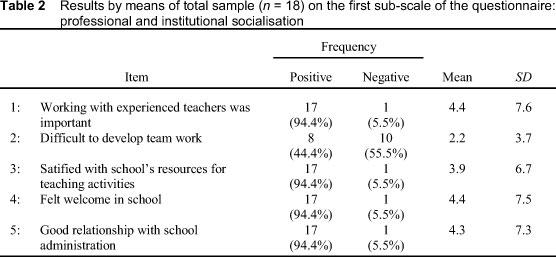
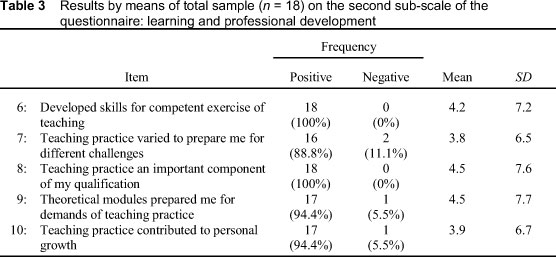
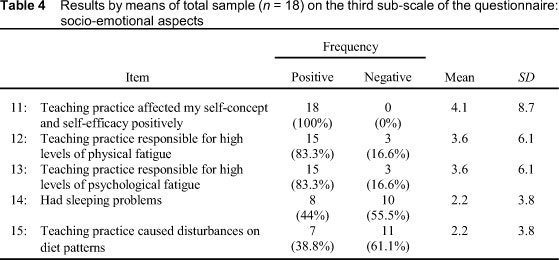
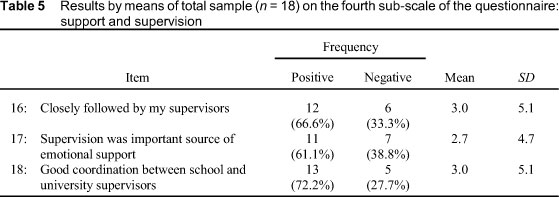
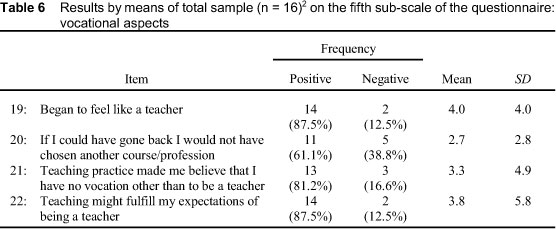
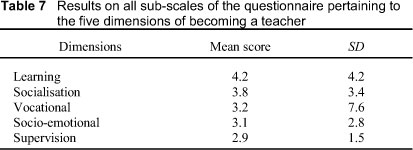
Sampling
The study was conducted at a South African higher education institution in 2010, at the end of the student teachers' ten weeks of teaching practice in approved, functional schools. A formal agreement was concluded between the schools and the higher education institution for this purpose. The target population (n = 153) were all BEd and PGCE (Senior phase and FET) students who were registered for the following two modules, Subject Didactics History (n =52) and Learning Area Didactics Social Sciences (n = 101). The teaching practice component of both programmes was identical, and facilitated in the student teachers' final year. A sampling ratio of 30% (n = 45) was decided on, following the sampling guidelines as provided by Grinnell and Williams (1990:127), who consider performing basic statistical procedures on a sample of 30 as sufficient. The sample size may be relatively small for a quantitative study; but the sampling frame contained the complete target population. The sampling approach used was simple random probability sampling where each individual case in the population theoretically has an equal chance of being selected for the sample. The lottery or fishbowl random selection technique was used. A symbol for each element of the population was written on identical pieces of paper, placed in a container, mixed well and then one number at a time was drawn. The sample included sub-groups of race (African, white, coloured and Indian, which was determined by means of a closed question in the questionnaire), gender (female and male), language (English, Afrikaans, Yoruba), class (lower, intermediate, managerial, administrative, supervision, professional) and age (between 20 and 40). The sample resembles the population in as many ways as possible; hence, the sampling error of biased selection and the sampling bias of under-representation were reduced.
Data collection
Self-administered structured questionnaires were used to collect the data. The student teachers were contacted by e-mail, telephone, or in person. Forty-five questionnaires were disseminated by hand or e-mail. The return rate of the questionnaires was 40% (n = 18). The summative scaling procedure was applied to the returned questionnaires.
Ethical considerations
During the data-collection process, all respondents were informed about the purpose, time demands, confidentiality, and voluntary nature of the study. The ethical criteria used for the process were tho se prescribed by the higher education institution where the research took place.
Results
The data from the questionnaires were assessed through statistical analysis using mean ranking scores. The Excel Data Analysis tool pack was used, and correctness of the calculations was checked manually. Mean values of 3 or greater were interpreted as high levels of success and low levels of difficulty. The quantitative data generated from the 22 opinion-related questions for the total sample (n = 18) are given in Table 2.
Table 2 summarises the frequency, percentage, mean score, and standard deviation of the student teachers' opinions regarding the socialisation dimension of becoming a teacher. The student teachers (n = 18) responded as follows to the five items of the first sub- scale: 17 (94.4%) responded positively to Items 1, 3, 4 and 5; only one (5.5%) responded negatively to these items. Eight (44.4%) responded positively and 10 (55.5%) negatively to Item 2. The majority of the sampled student teachers were considered to have responded positively to four of the five items, because the mean scores for the four items were greater than 3.0, namely, Items 1 and 4 (m = 4.4), Item 5 (m = 4.3), and Item 3 (m = 3.9). The student teachers viewed Item 2 as a negative, because the mean score for this Item was less than 3.0, namely 2.2.
Table 3 summarises the frequency , percentage, mean score, and standard deviation of the student teachers’ opinions pertaining to the learning dimension of becoming a teacher. The student teachers (n = 18) who were sampled responded to the five items of the second sub-scale in the following manner: All 18 (100%) student teachers responded positively to Items 6 and 8. Seventeen (94.4%) responded positively to Items 9 and 10, and one (5.5%) responded negatively to these two items. To Item 7, 16 (88.8%) responded positively and 2 (11.1%) negatively. The majority of the sampled student teachers viewed all five items as positive, because the mean scores for the five items were greater than 3.0, namely, Items 6 (m = 4.2), 7 (m = 3.8), 8 (m = 4.5), 9 (m = 4.5) and 10 (m = 3.9).
Table 4 summarises the frequency, percentage, mean score, and standard deviation of the student teachers’ opinions with regard to the socio-emotional dimension of becoming a teacher. The student teachers (n = 18) who were sampled responded as follows to the five items of the third sub-scale: All 18 (100%) student teachers responded positively to Item 11. Fifteen(83.3%) responded positively, and 3 (16.6%) negatively to Items 12 and 13. Eight (44.4%) responded positively, and 10 (55.5%) negatively to Item 14. To Item 15, 7 (38.8%) student teachers responded positively and 11 (61.6%) negatively. The majority of the sampled student teachers experienced three of the five items as positive, because the mean scores for these three items were greater than 3.0, namely, Item 11 (m = 4.1) and Items 12 and 13 (m = 3.6). The student teachers experienced Items 14 and 15 (m = 2.2) as negative, because the mean scores for the two items were less than 3.0, namely 2.2.
Table 5 summarises the frequency, percentage, mean score, and standard deviation of the student teachers’ opinions on the support and supervision dimension of becoming a teacher. The student teachers responded as follows to the three items of the fourth sub-scale: Of the 18, 12 (66.6%) responded positively, and 6 (33.3%) negatively to Item 16. Eleven (61.1%) responded positively and 7 (38.8%) negatively to Item 17. To Item 18, 13 (72.2%) responded positively, and 5 (27.7%) negatively. The majority experienced two of the three items as positive. They experienced Item 17 (m = 2.7) as negative.
Table 6 summarises the frequency, percentage, mean score, and standard deviation of the student teachers' opinions pertaining to the vocational dimension of becoming a teacher. The student teachers (n = 16) responded as follows to the four items of the fifth sub-scale: Of the 16, 14 (87.5%) responded positively, and 2 (12.5%) negatively to Item 19. Eleven (61.1%) responded positively, and 5 (38.8%) negatively to Item 20. To Item 21, 13 (81.2%) responded positively and 3 (16.6%) negatively. For Item 22, the responses of 14 (87.5%) were positive and 2 (12.5%) negative. The majority experienced three of the four items as positive, the mean scores for these items were, Items 19 (m = 4.0), 21 (m = 3.3) and 22 (m = 3.8). The student teachers' experience of Item 20 was negative, because the mean score for the item was 2.7.
Table 7 summarises the mean scores and standard deviations of the student teachers' opinions of the total sample (n = 18) with regard to the five dimensions of becoming a teacher. The sampled student teachers' responses pertaining to which dimensions they experienced as successful, and in which they encountered difficulties, were as follows: They experienced four of the five dimensions of becoming a teacher as positive, because the mean scores for these dimensions were learning (m = 4.2), socialisation (m = 3.8), and the vocational (m = 3.2) and socio-emotional (m = 3.1). With regard to the supervision dimension, they encountered some difficulties, because the mean score for this dimension was 2.9.
These findings are significant because they contain the results of a South African case study of the personal and socio-professional development of prospective teachers during tea- ching practice, using the five sub-scales of the internationally applied Inventory of Experiences and Perceptions at Teaching Practice (IEPTP). These findings can be added to the existing body of international research findings relating to the IEPTP.
Discussion
From the student teachers' responses to the first sub-scale, professional and institutional socialisation, it became clear that their teaching practice experience resulted in high levels of integration and satisfaction regarding their placement schools' atmosphere, and resources and quality of the relationships established with the different members of the school community. Apart from this, 55.5% of the student teachers indicated that one of the aspects of their socialisation, namely, team work in their placement schools, did not effectively facilitate their school experience. Schools influence the socialisation process of pre-service teachers. However, some schools have high levels of "collegiality", while others not. More than half of the student teachers who were involved in the study experienced low levels of "collegiality" from the staff in their placement schools. Farell (2008:226-241) concluded that a lack of team work usually results in no productive learning for student teachers and they may end up with very negative practicum experiences.
Concerning the second sub-scale learning and professional development, the student teachers' levels of successes were high. There was a significant level of personal perception of professional competency and high levels of self-confidence and perceptions of successes with regard to the acquired competence. Liaw (2009:176-180) confirms that when the teaching practice is well supported, involving close cooperation between student teachers, mentor teachers and teacher educators, the student teachers improve in their efficacy as teachers. The students involved in this study progressed through two of the three stages (concern for the self and concern about the teaching task) of Fuller's (1969:207-226) concerns in teacher development theory. The student teachers experienced feelings of self-adequacy; receiving positive feedback from the teacher educators and mentor teachers (Stage 1). They perceived no deterrents (such as too many non-instructional duties and poor instructional materials) to effective teaching (Stage 2). Fuller (1969:207-226) argues that his concern theory follows a hierarchical pattern; students advance through the stages by survival into an advanced development stage (the impact stage) addressing and resolving perceived problems at each consecutive stage.
The responses of the student teachers to the third sub-scale, the socio-emotional aspects, revealed that they are of the opinion that their teaching practice experience has positively affected their self-concept and self-efficacy, but, resulted in high levels of physical and psychological fatigue (83.3%). 44.4% also developed sleeping problems and 38.8% experienced disturbances on their diet patterns. Emotions are at the heart of teaching. Teaching is not only a technical or cognitive practice but also an emotional one. The student teachers' involvement in a wide range of activities was technically and emotionally challenging for them, especially because they were inexperienced and/or felt insufficiently skilled. According to Farell (2008: 226-241), these challenges are caused by, among other things, poor induction and socialisation of student teachers, lack of planning skills, and concerns about their own survival in the classroom and how to control the learners.
Lower levels of success were found in the fourth sub-scale of support and supervision. 33.3% of the student teachers indicated that they were not closely followed by their supervisors, 38.3% did not receive emotional support, and 27.7% were of the opinion that there was not good coordination between school mentors and university supervisors. Studies by Liaw (2009:176-180), Ong'ondo and Jwan (2009:415), and Tann (1994:81-93) on cooperation between student teachers, mentor teachers and teacher educators have shown that the collaboration of role-players can enhance student teacher learning. However, they also identified a number of issues that teacher education programmes need to resolve to improve collaboration, such as enhancing a shared understanding of the purpose of teaching practice between mentor teachers and student teachers, promoting a systematic approach to collaboration, and preparing the mentor teachers for their roles of working with student teachers. More quality collaboration between the teacher educator (the higher education institution), the mentor teacher (the school) and the student teacher is imperative. Each participant has to have a more clearly defined role to play: the teacher educator to guide the student teacher through the process, and a willing and competent mentor teacher to develop an induction plan, focus on instruction and support the professional development of the student teacher.
The results on the fifth sub-scale, the vocational aspects, revealed increasing successes with regard to the teaching profession in terms of personal, professional, social and/or financial fulfilment; and high levels of confidence in their vocation as teachers. Of the student teachers 61.1% indicated that if they could have gone back they would not have chosen a different profession, and 81.2% said that their teaching practice experience made them believe that they have no other vocation than to be a teacher. Consequently, the majority of the student teachers progressed to the professional socialisation phase of learning about the profession (Lawson & Stroot, 1993:437-446). As individuals who were strongly inclined toward teaching, the school experience was fulfilling and meaningful to the majority of the student teachers. The sense of teaching as a vocation came to life during their school experience. It provided them with a sense of self and personal identity.
The results on the sub-scales pertaining to all five dimensions of becoming a teacher, revealed that the student teachers experienced the most success in the following dimensions: learning (m = 4.2), socialisation (m = 3.8), vocational (m = 3.2) and socio-emotional (m = 3.1). They experienced more difficulties with regard to the supervision dimension (m = 2.9) compared to the other four dimensions. However, the mean score for this dimension was only slightly below 3 on the 5-point rating scale, which suggests that the difficulties encountered by the student teachers were not severe. This was an exploratory study, and the first stage in a sequence of studies on the professional development of student teachers during teaching practice.
Conclusion and recommendations
From the analysis of the student teachers' opinion on the significance of their teaching practice experience with regard to their personal and socio-professional development, it was clear that the process of becoming a teacher is complicated, and responsible for what could be considered as a real personal revolution for the students.
Higher levels of success were observed in respect of the socialisation, learning and vocational dimensions; and lower levels of success in the socio-emotional and supervision dimensions. These dimensions can therefore be assumed as the more problematic areas. The novelty, diversity and quantity of tasks, functions and responsibilities involved in the field experience, the management of the simultaneous roles of teacher and student, the assessment of the student teachers' performance by the supervisors, and the management of relationships with and between supervisors may explain the higher levels of difficulties encountered in the socio-emotional and supervision dimensions.
The problems that emerged in these two areas justify deliberate measures to diminish the negative impact that the difficulties could have on the process of learning to teach, and on student teachers' personal and socio-professional growth. The following two measures are recommended:
- Firstly, with regard to the socio-emotional dimension, it is recommended that there should be room for the exploration of the student teachers' feelings or emotions about their personal and professional growth, such as their vulnerability, enthusiasm and frustration. Hearing their own voices is crucial for the prospective teachers' self-knowledge, emotional balance, meaning construction process, and definition of their emerging identities as teachers (Caires & Almeida, 2005:118-120).
- Secondly, pertaining to the supervision dimension, Ralph's (2002:192) contextual supervision model is recommended. Within the contextual supervision model, the experience of learning to teach occurs within a particular context that is unique to the individual student teacher involved in the supervision relationship, the task being pursued, and the physical and psychological environment in which it occurs. In the contextual supervision model, the supervisor varies his/her supervision style according to the student teacher's particular developmental or readiness level to perform the specific task being learned. As the student teacher advances in his/her level of development in that particular knowledge component or task, the supervisor purposefully adjusts his/her supervision style to reflect the student teacher's growth.
The volume of research on the process of learning to teach at the higher education institution under study remains small. Consequently, the following topics are recommended for further research: a survey of the experiences of student teachers concerning the support they expect, need and obtain during their field experience; and, a study of the development of student teachers' pedagogical reasoning, namely, how their instrumental reasoning (knowledge of literature and teaching methods) and practical reasoning (teaching in the classroom) eventually result in the mastery of teaching.
Notes
1 Although History teachers were used as target population for the empirical study, the focus was not on their becoming History teachers, but on becoming teachers per se.
2 Two of the student teachers did not respond to this sub-scale.
References
Angen MJ 2000. Evaluating interpretive inquiry: Reviewing the validity debate and opening the dialogue. Qualitative Health Research, 10:378-395. [ Links ]
Borko H, Whitcomb J & Liston D 2009. Wicked problems and other thoughts on issues of technology and teacher learning. Journal of Teacher Education, 60:3-7. [ Links ]
Botha D & Nofomela S 2010. Teaching Practice. Port Elizabeth: NMMU. [ Links ]
Burn K, Hagger H, Mutton T & Everton T 2000. Beyond concerns with self: sophisticated thinking of beginning student teachers. Journal of Education for Teaching, 26:259-278. [ Links ]
Caires S & Almeida L 2005. Teaching Practice in Initial Teacher Education; its impact on student teachers' professional skills and development. Journal of Education for Teaching: International Research and Pedagogy, 31:111-120. [ Links ]
Darling-Hammond L 2006. Constructing 21st Century Teacher Education. Journal of Teacher Education, 57:1-15. [ Links ]
Dash, NK 1993. Research paradigms in Education: Towards a Resolution. Journal of Indian Education, 19:1-6. [ Links ]
Dean J 1996. Beginning Teaching in the Secondary School. Buckingham: Open University Press. Dellicarpini M 2009. Enhancing cooperative learning in teacher education. TESOL and ELT Journal, 63:42-50. [ Links ]
Department of Basic and Higher Education and Training 2011. Integrated Strategic Planning Framework for Teacher Education and Development in South Africa. 2011-2025. Pretoria: Government Printer. [ Links ]
Department of Higher Education and Training 2011. The Minimum Requirements for Teacher Education Qualifications. Pretoria: Government Printer. [ Links ]
Dodds P 1989. Trainees, field experience, and socialisation into teaching. Indianapolis: Bench Mark Press. [ Links ]
Farell TSC 2008. Here is the book, go and teach the class: ELT practicum support. RELC Journal, 29:226-241. [ Links ]
Flores MA 2007. Person and context in becoming a new teacher. Journal of Education for Teaching, 27:135-148. [ Links ]
Fuller F 1969. Concerns of teachers: A developmental conceptualization. American Educational Research Journal, 6:207-226. [ Links ]
Golombek PR 1998. A study of language teachers' personal practical knowledge. TESOL Quarterly, 32:447-464. [ Links ]
Grinnell RM & Williams M 1990. Research in social work: a primer. Itasca, IL: Peacock. [ Links ]
John P 1991. The professional craft knowledge of the history teacher. Teaching History, 64: 8-12. [ Links ]
Johnson, KE 1996. The vision versus reality: the tensions of the TESOL practicum. In D Freeman & JC Richard (eds). Teacher learning in language teaching. Cambridge: Cambridge University Press. [ Links ]
Kohler F, Henning JC & Usma-Wilches J 2008. Preparing pre-service teachers to make instructional decisions. An examination of data from the teacher work sample. Teaching and Teacher Education, 24:210-211. [ Links ]
Lawson H 1986. Occupation socialization and the design of teacher education programmes. Journal of Teaching in Physical Education, Monograph 2. [ Links ]
Lawson H & Stroot SA 1993. Footprints and signposts: perspectives on socialisation research. Journal of Teaching Physical Education, 12:437-446. [ Links ]
Liaw EC 2009. Teacher efficacy of pre-service teachers in Taiwan. The influence of classroom teaching and group discussions. Teachers and Teacher Education, 25:176-180. [ Links ]
Liston D, Whitcomb J & Borko H 2006. Too little or too much: teacher preparation and the first years of teaching. Journal of Teacher Education, 57:35-38. [ Links ]
Mouton J 2002. How to succeed in your master's and doctoral studies: a South African guide and resource book. Pretoria: Van Schaik. [ Links ]
Neurath O 1973. The scientific conception of the world: The Vienna Circle. In M Neurath & R Cohen (eds). Empiricism and sociology. Boston: Reidel. [ Links ]
Numrich C 1996. On becoming a language teacher: insights for diary studies. TESOL Quarterly, 30:131-153. [ Links ]
Ong'ondo CO & Jwan JO 2009. Research on student teachers' learning, collaboration and supervision during Teaching Practice: A literature review. Educational Research and Review, 4:415-424. [ Links ]
Phelan A 2009. The ethical claim of partiality: practical reasoning, the discipline, and teacher education. Journal of Curriculum Studies, 41:93-114. [ Links ]
Quick Q & Siebörger R 2005. What matters in practice teaching? The perceptions of schools and students. South African Journal of Education, 25:1-4. [ Links ]
Ralph EG 2002. Mentoring beginning teachers: findings from contextual supervision. Journal of Personnel Evaluation and Education, 16:191-210. [ Links ]
Robinson M 1999. ITE in a changing South Africa: experiences, reflections and challenges. Exam Papers & Reports. Paper 22 http://dk.cput.ac.za/ed_papers/22 [ Links ]
Solmon MA, Worthy T, Lee AM & Carter JA 1990. The role of a successful physical educator as perceived by physical education majors and teachers. Teaching Physical Education, 10:188-209. [ Links ]
Spalding E, Klecka CL, Lin E, Wang J & Odell SJ 2011. Learning to teach: It's complicated. But it's not magic. Journal of Teacher Education, 62:3-7. [ Links ]
Su JZX 1992. Sources of influence in pre-service teacher socialisation. Journal of Education and Teaching, 78:239-258. [ Links ]
Tann S 1994. Supporting the student teacher in the classroom. In MD Wilkin & D Sankey (eds). Collaboration and transition in initial teacher education. London: Kogan Page. [ Links ]
Tsang WK 2004. Teachers' personal practical knowledge and interactive decisions. Language Research, 8:163-198. [ Links ]
Williamson KM & Stroot SA 1994. Benefits, limitations and implications of collaborative research among beginning physical education teacher educators. The Physical Educator, 51:170-177. [ Links ]
Young P & Birds T 2009. Using embedded assessments to promote pedagogical reasoning among secondary teaching candidates. Teaching and Teaching Education, 10:1-16. [ Links ]














